
Warthog
Name
Warthog (Phacochoerus africanus)
Order - Artiodactyla
Family - Suidae
The name ‘warthog’ comes from this swine’s obvious facial warts, which are made up of thick skin and cartilage. Females have a single pair of warts just below the eyes while males have an additional pair just above the tusks. The warts on boars are much larger and this as well as the additional pair on the cheeks, help to protect their faces and eyes from opponents’ tusks during times of combat.
Appearance
A warthog boar weighs 60 to 100 kg, and a sow 45 to 70 kg. Their tusks have an average length of 25 cm. They can attain a running speed of 40 km/h.
Warthog Breeding
After a gestation period of three months, 1 - 8 piglets are born weighing 600 g each. Breeding occurs between the months of September and December in South Africa.
Warthog Behaviour
Warthogs are diurnal, spending most of their days foraging for food in a limited area. When feeding, they kneel on their front knees. They sleep in burrows at night, entering tail first. They usually occur in family groups, but three main groups exist socially namely matriarchal groups, bachelor groups and solitary boars. A matriarchal group comprises of adult sows and their young.
Boars only interact with sows during the mating period and are uninvolved with the rearing of the piglets. Bots boars and sows have more than a singular mating partner. Warthogs can be spotted at waterholes where they lie in the mud and dig in the marsh.
Warthog Habitat
Warthogs can live in a variety of habitats but are mostly found in the open woodland savannas of South Africa.
Where they are Found
Warthogs are widely distributed and unthreatened in South Africa and populate the open savanna areas around waterholes and marshes in the Kruger National Park. They can also be found on farms and have been reintroduced in regions where they had become extinct. They can also be found in Botswana, Mozambique, Zimbabwe, Kenya, Zambia and Tanzania.
Warthog Predators
Fully grown warthogs are threatened by the lion, cheetah, hyena, leopard and crocodile. Warthog young fall prey to the eagle and jackal.
Spoor Description
The warthog’s spoor is narrower than that of the bush pig. Their dewclaws are clearly imprinted in their spoors.
Field Notes
This animal is one of the most hunted prey in the African savanna, as a variety of predators prey on fully grown warthogs and their young.
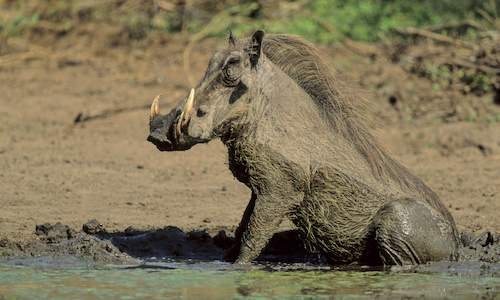
Warthogs are mostly hairless but what hair they do have serves vital functions. The mane of long, rough hair along their backs is erected, c...
more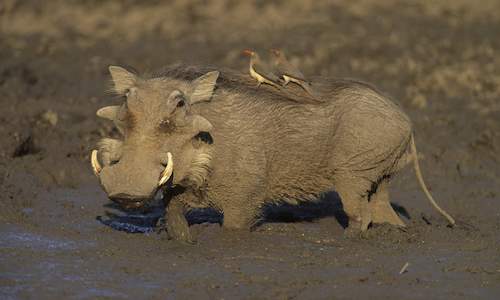
Prefers open ground: grassland, vleis, areas around waterholes, open woodland & scrub...
more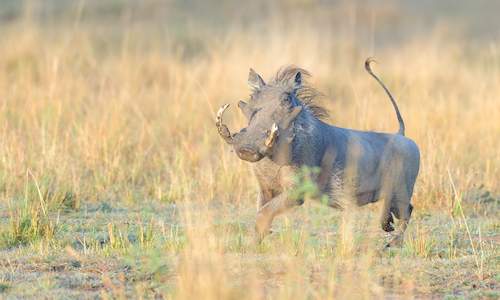
A warthog’s tusks are formidable defence weapons. They are modified canine teeth that grow sideways out of the warthog’s mouth and the u...
more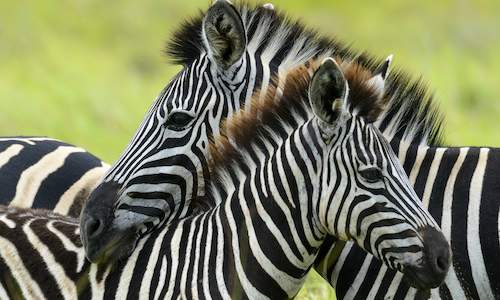
Learning about the mammals of South Africa is now so much easier for all South Africans - SouthAfrica.co.za is an excellent source of inform...
more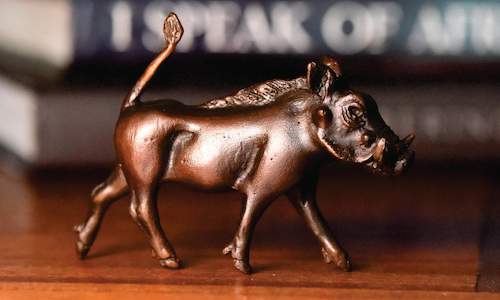
Crafted in exquisite detail and cast in bronze, the miniature bronze running warthog sculpture by Bruce Little is a timeless piece that wil...
more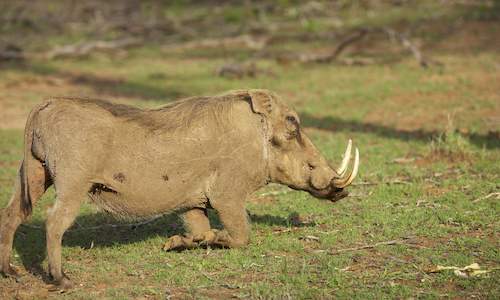
Warthogs are well equipped for their dietary habits. They have large, flattened molars and a modified jaw articulation perfect for grinding ...
more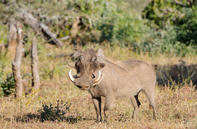
 Warthogs are mostly hairless but what hair they do have serves vital functions. The mane of long, rough hair along their backs is erected, c...
Warthogs are mostly hairless but what hair they do have serves vital functions. The mane of long, rough hair along their backs is erected, c... Prefers open ground: grassland, vleis, areas around waterholes, open woodland & scrub...
Prefers open ground: grassland, vleis, areas around waterholes, open woodland & scrub... A warthog’s tusks are formidable defence weapons. They are modified canine teeth that grow sideways out of the warthog’s mouth and the u...
A warthog’s tusks are formidable defence weapons. They are modified canine teeth that grow sideways out of the warthog’s mouth and the u... Learning about the mammals of South Africa is now so much easier for all South Africans - SouthAfrica.co.za is an excellent source of inform...
Learning about the mammals of South Africa is now so much easier for all South Africans - SouthAfrica.co.za is an excellent source of inform... Crafted in exquisite detail and cast in bronze, the miniature bronze running warthog sculpture by Bruce Little is a timeless piece that wil...
Crafted in exquisite detail and cast in bronze, the miniature bronze running warthog sculpture by Bruce Little is a timeless piece that wil... Warthogs are well equipped for their dietary habits. They have large, flattened molars and a modified jaw articulation perfect for grinding ...
Warthogs are well equipped for their dietary habits. They have large, flattened molars and a modified jaw articulation perfect for grinding ...